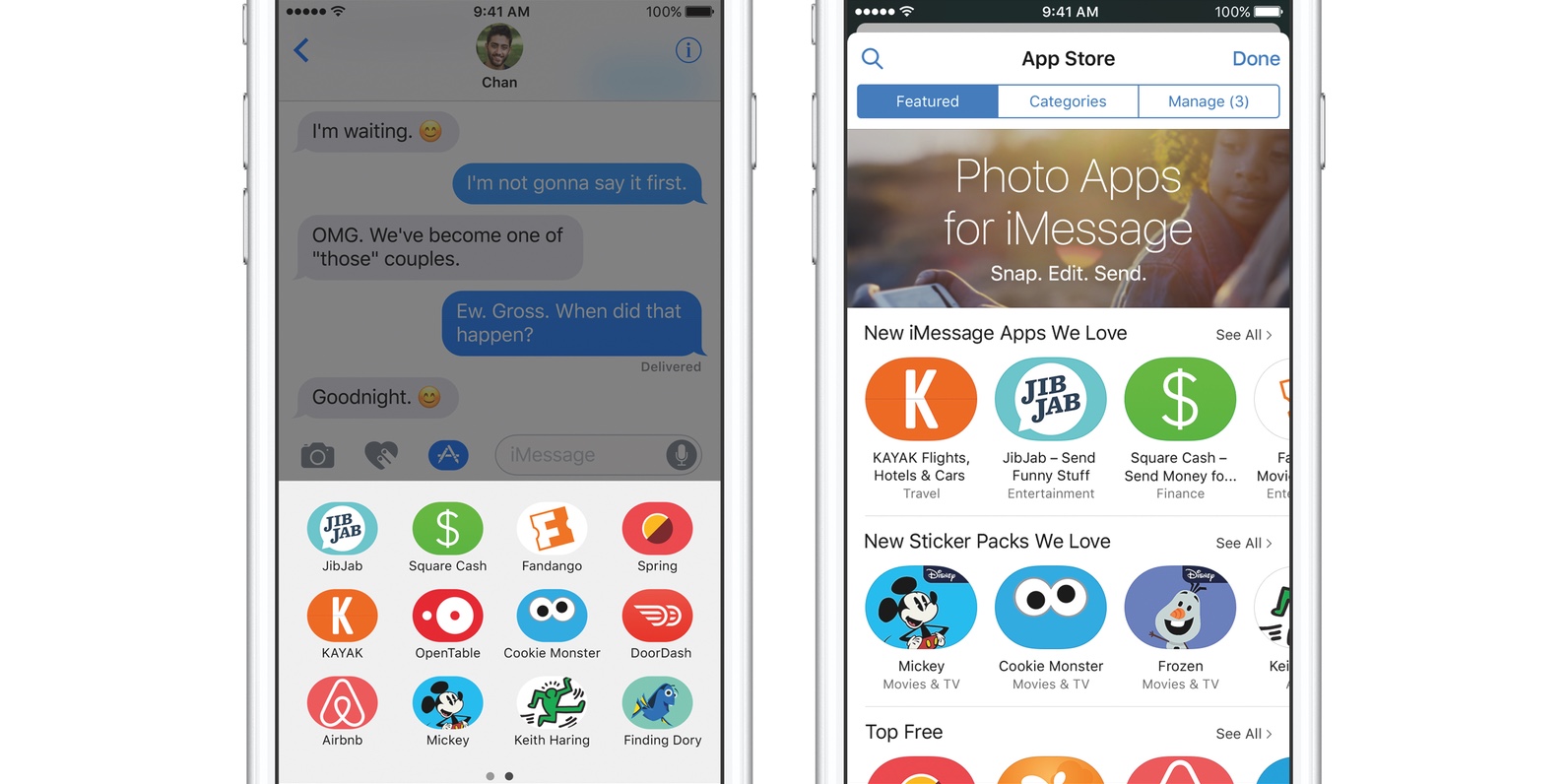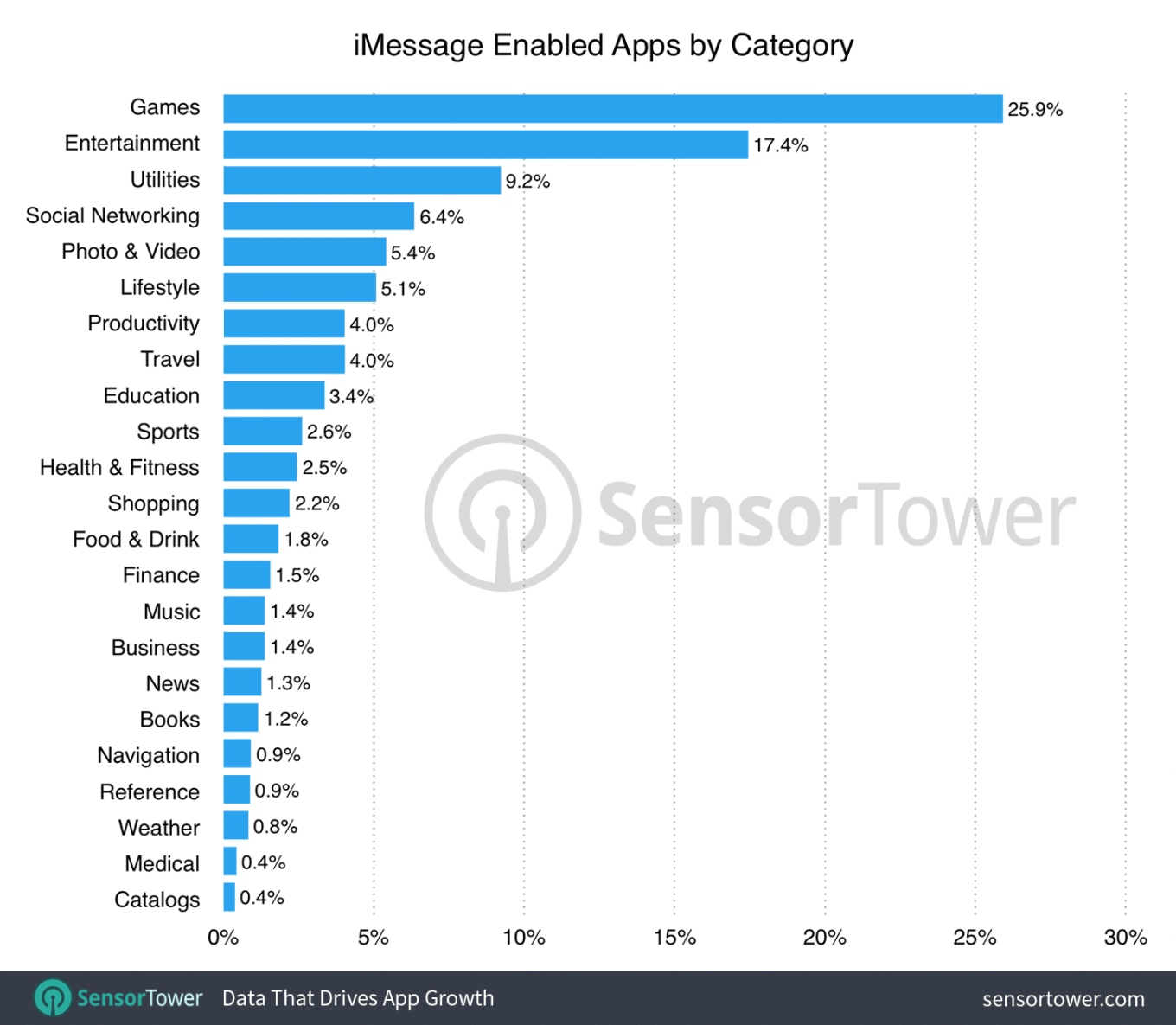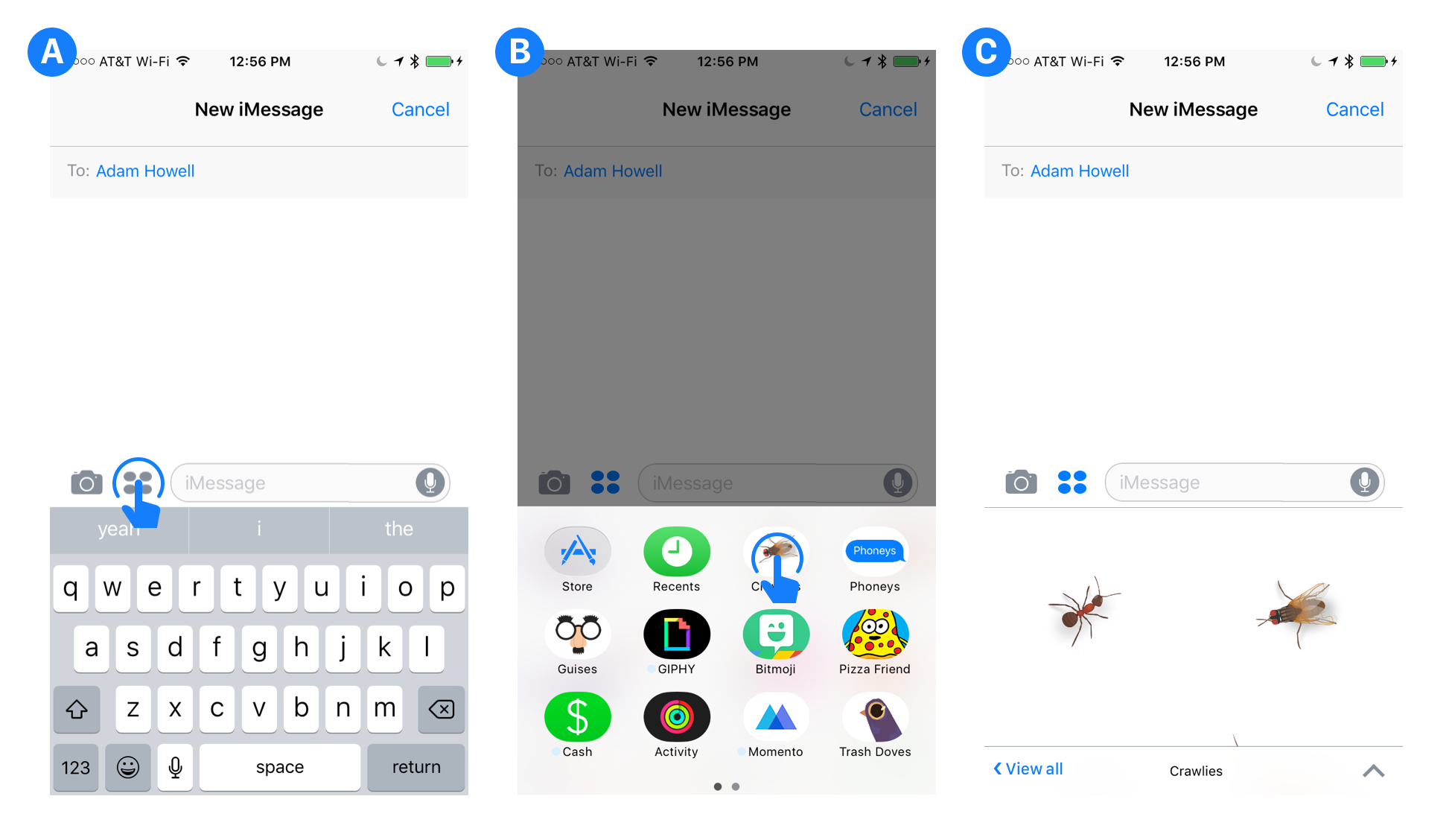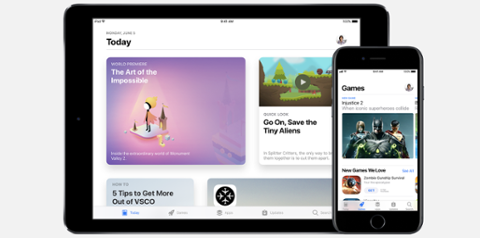[caption id="attachment_137241" align="aligncenter" width="1592"]

iMessage Apps[/caption] For all the attention we pay to iOS as a platform friendly to developers, it seems some are losing interest in a key component of it: iMessage. A
new study by analytics firm Sensor Tower shows that growth has essentially stalled in the iMessage App Store. In January and February, the number of apps for iMessage grew nine percent. Not bad, but December 2016 alone saw 65 percent growth; between the iMessage App Store’s launch in September 2016 and October 2016, it grew 116 percent. In total, there are just under 5,000 iOS apps available for iMessage. Sounds impressive, but there are 2.2 million iOS apps total. That’s 0.23 percent of iOS apps that have made their way to the iMessage App Store. Games are the most ‘ported’ titles, commanding 25.9 percent of the apps available for iMessage. Entertainment apps are second with 17.4 percent, followed by Utilities at 9.2 percent. It trails off steadily from there, as you can see in the image below. There could be several reasons for this slowdown. It’s possible developers just don’t see much value in iMessage apps; not every app can have its own microclimate to live in. For example: Fantastical, my favorite cross-platform calendar app for macOS and iOS, has stickers but no dedicated scheduler if I want to try to arrange lunch with a friend. We’ve seen this before, too. When iOS first opened up to third-party keyboard apps, the initial uptake was incredible. Since then, things have leveled off in a big way. There are only so many clever features or opportunities users will appreciate. [caption id="attachment_140517" align="aligncenter" width="1360"]

iMessage App Store breakdown[/caption]
Design-First Thinking
In a
post on Medium, developer Adam Howell considers the design of Apple’s iMessage App Store as a major detractor. While Apple predictively opens the last iMessage app you used when you actually dive into your app drawer, it can still take up to five or six clicks to send something as simple as a sticker. Loading
new apps is also unintuitive. It’s four clicks just to get into the iMessage App Store, where only 0.23 percent of your phone’s apps are, anyway. From there, you’re left to fumble through a familiarly wonky App Store search engine to find what you want. Howell’s proposal is to shield everything behind one menu next to the text field for iMessage. He offers up Digital Touch as a sacrifice for the redesign (and if you’re not sure what
Digital Touch is, that’s a good reason to get rid of it), and suggests that the next screen should just open into the app drawer. Those time-saving techniques make iMessage apps more boilerplate and less intrusive, which could spurn more downloads. It doesn’t solve some of the other niggles with the iMessage App Store, though. As Howell points out, many users don’t quite understand what happens to apps after they’re downloaded, and how to place stickers over messages still elude some people. Simply knowing how to perform searches in an iMessage app can be tricky. For developers, it presents a unique set of issues. Sticker packs can be created and submitted in short order, but why put forth any effort if users don’t quite understand how the app works? My favorite funny grammar-shaming app, Grammar Snob, has a slew of one-star reviews because users thought it
actually edited the messages others sent. That sort of behavior, by the way, is discouraged. Howell’s own iMessage app, Phoneys, used stickers that looked like regular text bubbles. You’d place it over a message sent by someone else, and it would look like they were paying you a compliment (or calling you names). Phoneys was popular, and Apple forced it out of the iMessage App Store
because it considered such behavior trolling. [caption id="attachment_140518" align="aligncenter" width="1950"]

iMessage App Redesign[/caption]
What’s Next for Apple and iMessage?
Sensor Tower notes that 5,000 iMessage apps is eerily similar to the number of apps released to the App Store in its first year of existence back (in 2008). That’s an interesting takeaway but an inconsistent comparison. Mobile app development was just blossoming then, and having a smartphone was still a luxury instead of practically a commodity item. Howell’s suggestion that Apple redesign how we access iMessage apps may not be that far-fetched. Apple is no stranger to refactoring what doesn’t work. It did just that when creating the second and third iterations of watchOS. Finding a better way forward for iMessage apps is undoubtedly on the table in Cupertino. That redesign may also serve a new master. iMessage still lacks Siri, and holdouts still need a reason to care about messaging as a service. All signs point to Apple expanding its A.I. horizons on all fronts, iMessage included. Siri’s use-cases for developers are limited to a few categories, but expanding the digital assistant to messages may serve as a jumping-off point for iMessage apps, as well. The iMessage App Store hasn’t reached critical mass, but it’s something most iPhone users touch daily. It’s a revenue source for Apple, and presents as much opportunity for users as Facebook Messenger, We Cha, or other messaging services of the same ilk. Whether or not Apple agrees with Howell or not, numbers don’t lie. If Sensor Tower is on the nose (or even close), Apple has to rethink iMessage apps in a big way.
 iMessage Apps[/caption] For all the attention we pay to iOS as a platform friendly to developers, it seems some are losing interest in a key component of it: iMessage. A new study by analytics firm Sensor Tower shows that growth has essentially stalled in the iMessage App Store. In January and February, the number of apps for iMessage grew nine percent. Not bad, but December 2016 alone saw 65 percent growth; between the iMessage App Store’s launch in September 2016 and October 2016, it grew 116 percent. In total, there are just under 5,000 iOS apps available for iMessage. Sounds impressive, but there are 2.2 million iOS apps total. That’s 0.23 percent of iOS apps that have made their way to the iMessage App Store. Games are the most ‘ported’ titles, commanding 25.9 percent of the apps available for iMessage. Entertainment apps are second with 17.4 percent, followed by Utilities at 9.2 percent. It trails off steadily from there, as you can see in the image below. There could be several reasons for this slowdown. It’s possible developers just don’t see much value in iMessage apps; not every app can have its own microclimate to live in. For example: Fantastical, my favorite cross-platform calendar app for macOS and iOS, has stickers but no dedicated scheduler if I want to try to arrange lunch with a friend. We’ve seen this before, too. When iOS first opened up to third-party keyboard apps, the initial uptake was incredible. Since then, things have leveled off in a big way. There are only so many clever features or opportunities users will appreciate. [caption id="attachment_140517" align="aligncenter" width="1360"]
iMessage Apps[/caption] For all the attention we pay to iOS as a platform friendly to developers, it seems some are losing interest in a key component of it: iMessage. A new study by analytics firm Sensor Tower shows that growth has essentially stalled in the iMessage App Store. In January and February, the number of apps for iMessage grew nine percent. Not bad, but December 2016 alone saw 65 percent growth; between the iMessage App Store’s launch in September 2016 and October 2016, it grew 116 percent. In total, there are just under 5,000 iOS apps available for iMessage. Sounds impressive, but there are 2.2 million iOS apps total. That’s 0.23 percent of iOS apps that have made their way to the iMessage App Store. Games are the most ‘ported’ titles, commanding 25.9 percent of the apps available for iMessage. Entertainment apps are second with 17.4 percent, followed by Utilities at 9.2 percent. It trails off steadily from there, as you can see in the image below. There could be several reasons for this slowdown. It’s possible developers just don’t see much value in iMessage apps; not every app can have its own microclimate to live in. For example: Fantastical, my favorite cross-platform calendar app for macOS and iOS, has stickers but no dedicated scheduler if I want to try to arrange lunch with a friend. We’ve seen this before, too. When iOS first opened up to third-party keyboard apps, the initial uptake was incredible. Since then, things have leveled off in a big way. There are only so many clever features or opportunities users will appreciate. [caption id="attachment_140517" align="aligncenter" width="1360"]  iMessage App Store breakdown[/caption]
iMessage App Store breakdown[/caption]
 iMessage App Redesign[/caption]
iMessage App Redesign[/caption]


